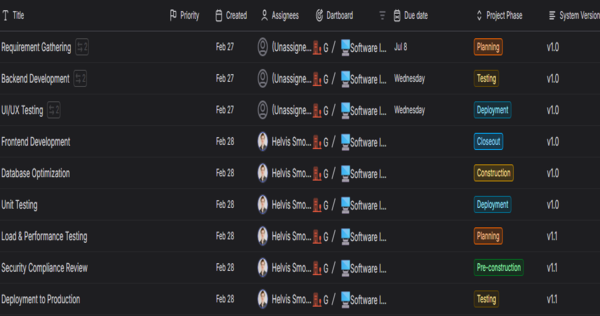Delivering successful engineering projects requires clarity, structure, and smooth collaboration. Without a standardized reporting framework, teams risk misalignment, delays, and inefficiencies.
Dart’s engineering project report template transforms complex technical data into actionable insights. It ensures stakeholders stay informed, risks are mitigated, and projects stay on track.
Engineering Project Report in Action: Key Components
This template provides a structured approach to documenting, analyzing, and communicating project progress with precision:
1. Project Overview & Objectives
Define and write the project scope, goals, and success metrics.
Example:
- Objective: Develop a scalable API for real-time data processing.
- Success Metrics: 99.9% uptime, < 500ms response time.
2. Stakeholder & Team Roles
Identify key contributors (engineers, PMs, clients) and their responsibilities.
Example:
- Lead Engineer: Oversees technical execution.
- Product Manager: Aligns deliverables with business goals.
3. Progress Tracking & Milestones
Visualize timelines with Gantt charts or sprint updates.
Example:
- Milestone: Beta release by Q3.
- Current Status: Backend development 80% complete.
4. Risk Assessment & Mitigation
Proactively flag technical or operational risks.
Example:
- Risk: Third-party API latency.
- Mitigation: Implement caching layer.
5. Technical Specifications & Challenges
Document architecture, tools, and roadblocks.
Example:
- Tech Stack: Python, AWS Lambda, React.
- Challenge: Database optimization required.
6. Budget & Resource Allocation
Track spend vs. forecast with real-time updates.
Example: Allocated: $50K | Spent: $42K | Variance: +16%.
7. Testing & QA Summary
Report on test coverage, bugs, and resolutions.
Example:
- Unit Tests Passed: 95%
- Critical Bugs Resolved: 8/10.
8. Next Steps & Action Items
Outline priorities and ownership.
Example:
- Action: Optimize database queries (Owner: Dev Team).
- Deadline: June 30.
Implementation Roadmap: From Planning to Continuous Improvement

A well-structured plan is only as strong as its execution. This 3-phase roadmap ensures seamless adoption of our template:
Phase 1: Setup & Documentation
Standardize reporting formats across teams. Integrate with Dart’s dashboard for real-time updates.
Phase 2: Execution & Monitoring
Weekly syncs to review progress and bottlenecks in project workflows. Take advantage of automated alerts for budget/timeline deviations.
Phase 3: Review & Optimization
Rely on retrospectives to refine future reports. Export insights for stakeholder presentations.
Why Generic Reports Fail
Traditional engineering reports often create more confusion than clarity. The following pitfalls lead to delays, rework, and missed objectives:
- Static Data: Manual updates lead to outdated insights.
- Poor Risk Visibility: Late-stage surprises derail projects.
- Stakeholder Misalignment: Unclear communication slows decisions.
DART’s template solves these by:
- Centralizing data for transparency.
- Automating updates to save time.
- Standardizing communication across teams.
Elevate Your Engineering Project Reporting
Effective engineering project management hinges on clear communication, structured documentation, and proactive risk mitigation. By adopting this template, engineering teams can focus on proactive project execution.







